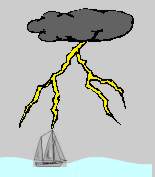This is one episode I will never
forget as it almost stopped our dream even before it began... read on for this
electrifying story.
After 4 years of preparation by my new owners, Bob and Judi, we were
finally headed into the open ocean to set off on our dream. They
still didn't know how to properly sail me, but I had confidence in
them and their abilities. My boat pals and I had been eagerly
waiting in port as we watched several weather fronts pass by, but finally,
the skipper decided the time was right to head out and get across the Gulf
Stream. Bob stood proudly at my helm as he steered out of
the inlet at Beaufort, North Carolina. My bow pitched and yawed in
the moderate seas, but I was reveling in the conditions and, at long last,
was able to fill my sails and show them what I could really do.
We were about 8 days out - still 2 days from the Virgin Islands
and had encountered squally, blustery conditions for several
days. My
decks were awash with water from going to windward, but we were all
handling the conditions well. Bob and Judi had set up our newest
crew member, Betsy, the Monitor windvane and we were both doing our best
to pick our way through the really big waves. That evening, when my
skipper checked in with Herb, he was told of a nasty low pressure system
right in our path, so Bob made the decision to alter course to the West to
try to miss the worst of it.
Unfortunately, that strategy did not work and around midnight we sailed
right into the heart of the storm. Even with my experience with New
England nor'easters and gales, this was one of the worst
lightning storms I had ever encountered.  With winds gusting up to 40
knots, Bob, took over the helm from Betsy and hand-steered while Judi
bailed, as the rain was coming down so hard that it had started to fill up
the cockpit. The lightning was continuous, like a strobe light, with bolts
striking the water all around my hull and illuminating the huge seas
around us. Tumultuous cracks of thunder were coming right on
top of the flashes. With winds gusting up to 40
knots, Bob, took over the helm from Betsy and hand-steered while Judi
bailed, as the rain was coming down so hard that it had started to fill up
the cockpit. The lightning was continuous, like a strobe light, with bolts
striking the water all around my hull and illuminating the huge seas
around us. Tumultuous cracks of thunder were coming right on
top of the flashes.
It was just a matter of time before we were hit and, sure enough, one
tremendous bolt did finally strike the top of my mast - Ouch!
that really hurt. Judi felt a slight charge as she was scooping up
some water and Bob saw sparks fly from the VHF antenna, but felt nothing
as he was holding my wooden wheel in a "death-grip.".
After first checking to see if they were both in one piece, Judi went
below to check for damage to me. Fortunately, all my thru-hull
fittings were intact and I was not taking on water. But, we were
not totally unscathed, as the next drama highlighted. As Bob checked
the battery charging instruments, he saw that they were being drained very
quickly; so in spite of the storm raging around us, he had to tear apart
the battery compartment to find the problem. It seems that the
shore-side battery charger was damaged by the strike, was shorting-out and
draining the batteries. Since we certainly did not need the charger,
Bob quickly disconnected it and that solved the problem.
Altogether, the things that were damaged included:
- Wind Instrument, gone.
- Depth and Knotmeter instruments, not working.
- VHF antenna - gone
- Ham radio tuner damaged
|
- Stereo radio
- Shore-side battery charger
- Judi's nerves
|
|
In spite of this, we were all counting our blessings as we were all
alive and OK. The thru-hull fittings on my hull have all been bonded
together and the skipper is still not 100% sure if that is the reason we
sustained no damage, but he has decided not to fool with success, even
after reading everything he could on the subject later in port. After 2 months in St. Thomas replacing the damaged items, we were again
on our way to cruise the Caribbean and continue with our dream.
I had my doubts about them during this time, as I worried about whether
they would pack-it-in, but after a few weeks in a beautiful tropical
location, the bad memories faded away.
|
Lessons Learned
- Learn about the weather in your area. We thought that these
fronts would quickly move away in a day as they do in the northern
latitudes, when, in fact, in the sub-tropical latitudes, the systems
tend to move west to east more slowly and frequently stall.
- Bond the rigging to create a "cone of protection"
- During lightning storms, disconnect electronics, where
possible.
|
- If possible, keep in daily radio contact with another
boat or someone like "Herb" on shore.
- Always carry a spare hand-held VHF radio, with lots of
batteries
- Where possible, have back-up instruments. We now have
both a manual wind-instrument and spare depth sounder and both a Ham
radio and a SSB radio.
|
[The next story was a lucky
chance]
|